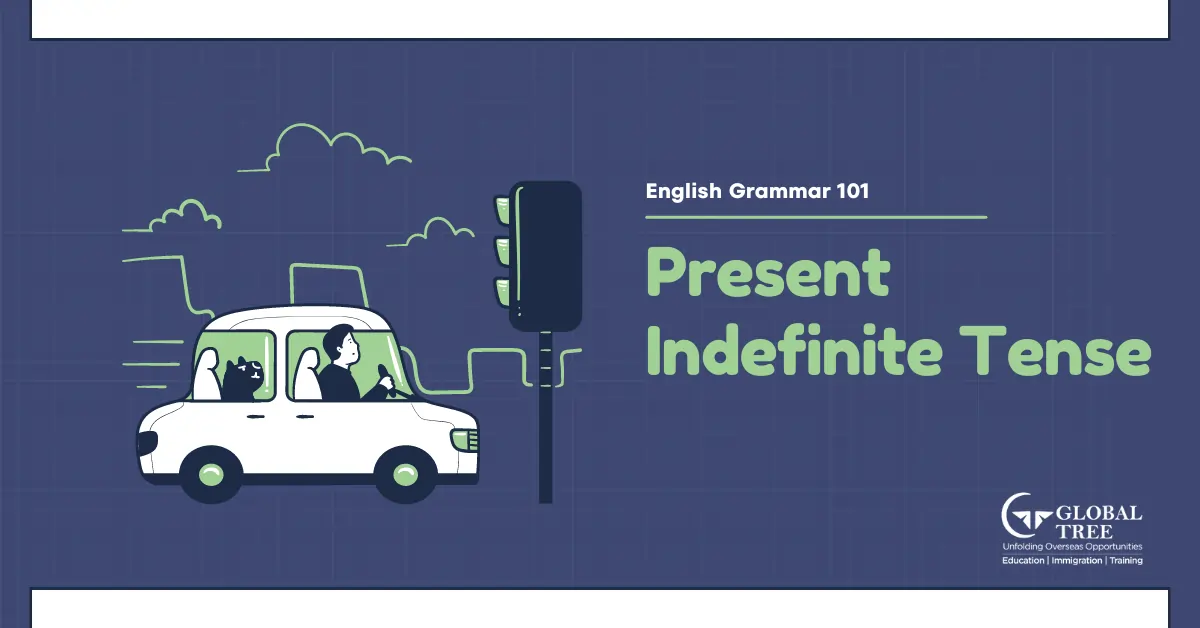What is Present Indefinite Tense: Meaning, Structure, Example & Exercise

- English Present Indefinite Tense
- Define Present Indefinite Tense
- Key Uses of the Present Indefinite Tense
- Structure of the Present Indefinite Tense
- Present Indefinite Tense Rule
- Present Indefinite Negative Sentences
- Present Indefinite Question Sentences
- Common Mistakes and Tips to Avoid in Present Indefinite Tense
- Present Indefinite Tense Exercises
- Conclusion
- Frequently Asked Questions
English Present Indefinite Tense
The Present Indefinite Tense, also known as the Simple Present Tense, is one of the most fundamental aspects of English grammar. Mastering this tense is crucial for effective communication, especially for Indian students preparing to study abroad. This article delves into the meaning, structure, and examples of the Present Indefinite Tense, providing a comprehensive guide to help students enhance their English language skills.
Define Present Indefinite Tense
The Present Indefinite Tense is used to describe actions that are habitual, general truths, or states that are currently happening. Unlike other tenses, it does not specify when an action occurs; rather, it indicates regularity or permanence.
[Read More: How to Improve English Skills Quickly?]
Key Uses of the Present Indefinite Tense
- Habitual Actions: It describes routines or habits.
- Example: "I study every day."
- General Truths: It states facts or universal truths.
- Example: "The sun rises in the east."
- Permanent Situations: It indicates situations that are generally or permanently true.
- Example: "She lives in Mumbai."
- Scheduled Events: It is used for events that are part of a fixed timetable.
- Example: "The train leaves at 6 PM."
Structure of the Present Indefinite Tense
Understanding the structure of the Present Indefinite Tense is essential for constructing accurate sentences. The structure varies slightly depending on the subject of the sentence.
[Read More: What is the most hardest Language in the world?]
Present Indefinite Tense Rule
The basic formula for Present Indefinite tense affirmative sentences is:
|
Subject + Base Form of the Verb + (Optional Object/Complement) Subject+Base Form of the Verb+(Optional Object/Complement) |
For third-person singular subjects (he, she, it), an 's' or 'es' is added to the base form of the verb.
- First Person Singular/Plural: "I/We play."
- Second Person Singular/Plural: "You play."
- Third Person Singular: "He/She/It plays."
- Third Person Plural: "They play."
Present Indefinite Negative Sentences
The structure for negative sentences includes the auxiliary verb 'do not' (don't) or 'does not' (doesn't) for third-person singular.
|
Subject + Do/Does Not + Base Form of the Verb + (Optional Object/Complement) Subject+Do/Does Not+Base Form of the Verb+(Optional Object/Complement) |
- First Person Singular/Plural: "I/We do not (don't) play."
- Second Person Singular/Plural: "You do not (don't) play.".
- Third Person Singular: "He/She/It does not (doesn't) play."
- Third Person Plural: "They do not (don't) play."
[Suggested Read: Use these Idioms to make your English more Professional]
Present Indefinite Question Sentences
For forming questions, the structure involves placing the auxiliary verb 'do' or 'does' before the subject.
|
Do/Does + Subject + Base Form of the Verb + (Optional Object/Complement) ? Do/Does+Subject+Base Form of the Verb+(Optional Object/Complement)? |
- First Person Singular/Plural: "Do I/We play?"
- Second Person Singular/Plural: "Do you play?"
- Third Person Singular: "Does he/she/it play?"
- Third Person Plural: "Do they play?"
- Examples of Different Structures
- Affirmative: "She writes letters."
- Negative: "She does not write letters."
- Interrogative: "Does she write letters?"
[Suggested Read: Strengthen your Vocabulary with these Synonyms]
Common Mistakes and Tips to Avoid in Present Indefinite Tense
While learning the Present Indefinite Tense, students often make certain mistakes. Here are some common errors and tips to avoid them:
- Incorrect Subject-Verb Agreement: Ensure the verb agrees with the subject.
- Incorrect: "He go to school."
- Correct: "He goes to school."
- Omitting the 's' or 'es' with Third Person Singular: Remember to add 's' or 'es' with third person singular subjects.
- Incorrect: "She read books."
- Correct: "She reads books."
- Using Continuous Form Instead of Simple Present: Use the base form of the verb for habitual actions, not the continuous form.
- Incorrect: "I am going to the gym every day."
- Correct: "I go to the gym every day."
- Neglecting 'Do/Does' in Negative Sentences: Always include 'do/does not' in negative sentences.
- Incorrect: "She not likes coffee."
- Correct: "She does not like coffee."
- Forming Questions Without Auxiliary Verbs: Use 'do/does' at the beginning of interrogative sentences.
- Incorrect: "You like pizza?"
- Correct: "Do you like pizza?"
[Suggested Read: Best Books to Improve English Vocabulary]
Present Indefinite Tense Exercises
To master the Present Indefinite Tense, practice is essential. Here are some exercises for students:
Exercise 1: Fill in the Blanks
He ___ (play) cricket on Sundays.
They ___ (not/like) spicy food.
___ (Do) you ___ (know) the answer?
She ___ (read) a new book every week.
The train ___ (leave) at 8 AM.
Exercise 2: Convert to Negative
She eats an apple daily.
They go to the park every evening.
He studies in the library.
We watch movies on weekends.
The cat sleeps on the sofa.
Exercise 3: Convert to Interrogative
They travel to Delhi often.
She speaks Spanish fluently.
He cooks dinner for the family.
You enjoy playing chess.
The school starts at 9 AM.
Answers to Exercises
Exercise 1: Fill in the Blanks
He plays cricket on Sundays.
They do not like spicy food.
Do you know the answer?
She reads a new book every week.
The train leaves at 8 AM.
Exercise 2: Convert to Negative
She does not eat an apple daily.
They do not go to the park every evening.
He does not study in the library.
We do not watch movies on weekends.
The cat does not sleep on the sofa.
Exercise 3: Convert to Interrogative
Do they travel to Delhi often?
Does she speak Spanish fluently?
Does he cook dinner for the family?
Do you enjoy playing chess?
Does the school start at 9 AM?
[Suggested Read: Detailed Explination on Countable and Uncountable Nouns]
Conclusion
The Present Indefinite Tense is a vital component of English grammar, especially for Indian students preparing to study abroad. Understanding its meaning, structure, and correct usage is crucial for effective communication. By practicing regularly and being mindful of common mistakes, students can master this tense and improve their overall proficiency in English. This guide serves as a comprehensive resource, aiding students in their journey to becoming confident English speakers.
Frequently Asked Questions
1. What is the Present Indefinite Tense?
The Present Indefinite Tense (also called the Simple Present Tense) is used to express habits, universal truths, general facts, and regular actions.
2. What is the sentence structure of Present Indefinite Tense?
- Affirmative: Subject + base verb (+ s/es for he, she, it) + object
- Negative: Subject + do/does not + base verb + object
- Interrogative: Do/Does + subject + base verb + object
3. When do we use "do" and "does" in Present Indefinite Tense?
Use "do" with I, you, we, they, and "does" with he, she, it in negative and interrogative sentences.
4. What are some common examples of Present Indefinite Tense?
- She reads a book every night.
- They play football on Sundays.
- Water boils at 100°C.
- He does not like coffee.
5. What is the difference between Present Indefinite and Present Continuous Tense?
Present Indefinite is used for regular or habitual actions, while Present Continuous describes actions happening right now or around the current time.
6. Do we use Present Indefinite Tense for scheduled events?
Yes, it is often used for fixed schedules or timetables.
Example: The train leaves at 6 PM.
7. How do you form questions in the Present Indefinite Tense?
Use "do" or "does" before the subject:
Example: Do you like ice cream? / Does she work here?
8. Is it correct to add “-s” or “-es” to all verbs in Present Indefinite?
Only add -s or -es to the verb when the subject is he, she, or it in affirmative sentences.
Example: He goes to school.
9. Can Present Indefinite Tense be used with adverbs of frequency?
Yes, it's commonly used with words like "always," "never," "often," "usually," and "sometimes."
Example: I always wake up early.
10. How can I practice Present Indefinite Tense effectively?
Practice by forming sentences about daily routines, doing gap-fill exercises, rewriting incorrect sentences, and answering simple questions in the tense.


